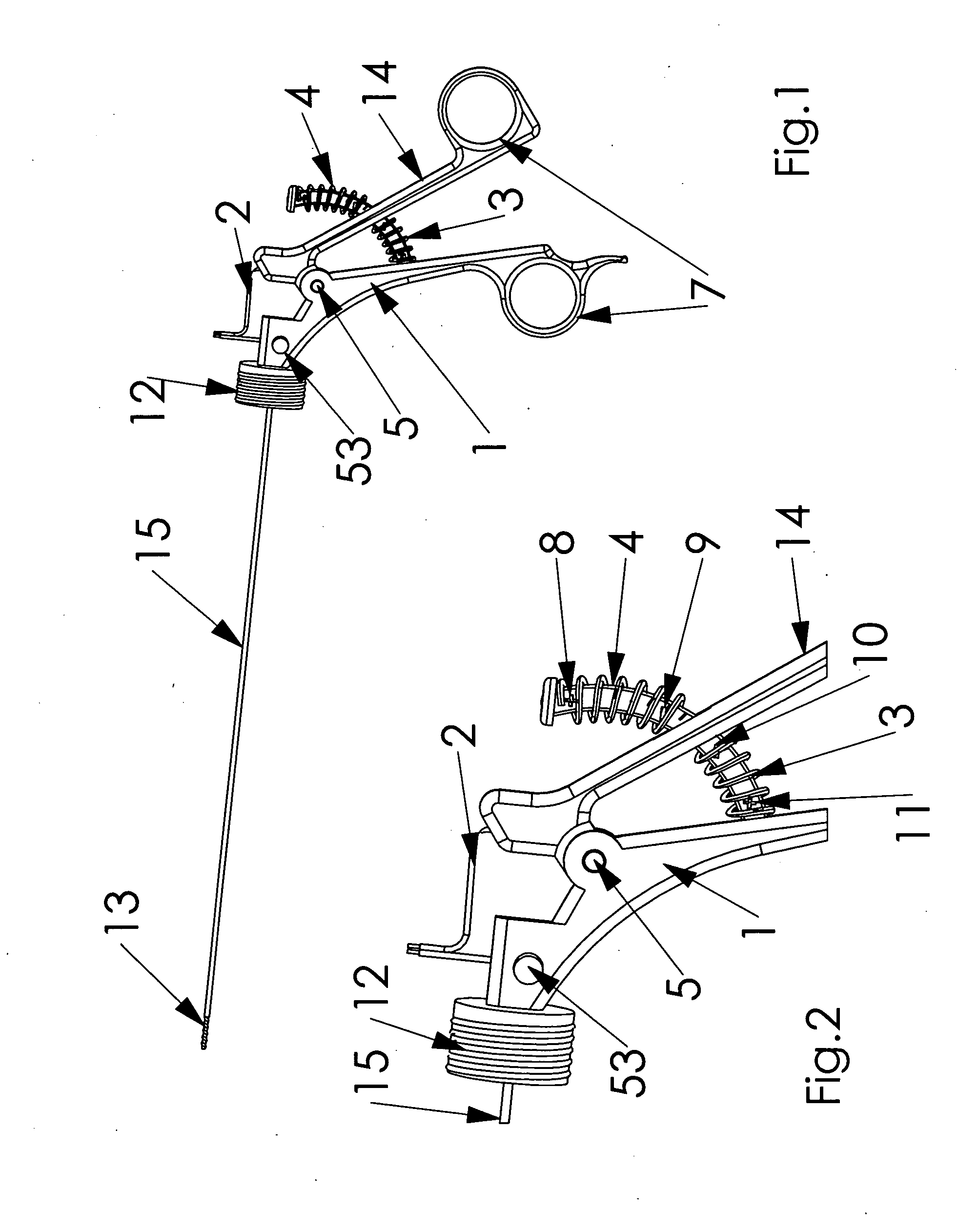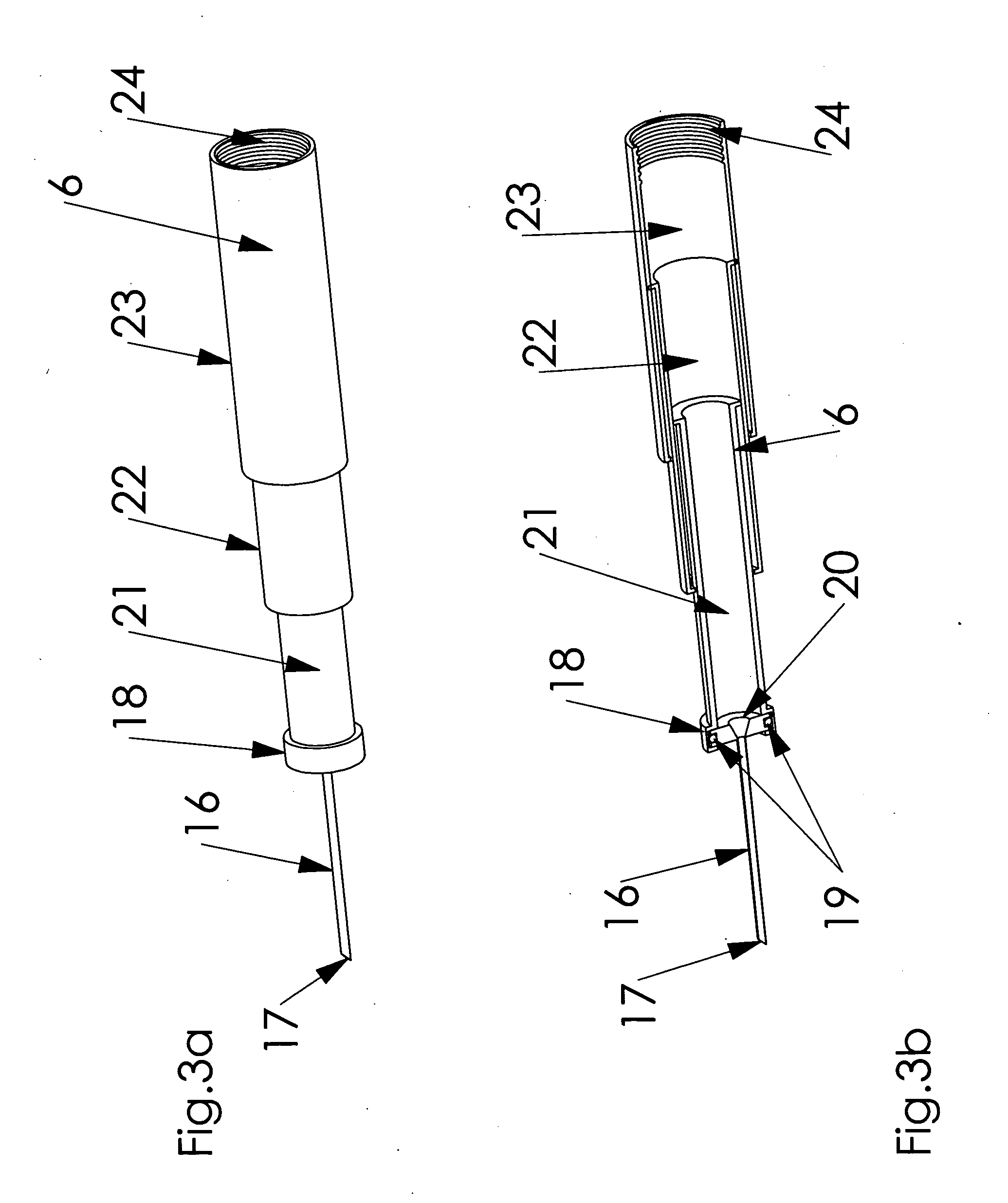[0005]Although surgical and other medical procedures have undergone much advancement over the years to simplify them, reduce their duration of use, require less manpower, improve cosmetic outcome, and/or lessen the time needed for patient recovery, there still is opportunity for improvement in all of these areas when the procedure requires entry through a cavity wall, particularly relating to reduced patient recovery time and a good cosmetic result. Thus, instead of making one or more lengthy incisions at the beginning of a surgical or other medical procedure to create one large access opening near to the organ or tissue needing surgical assistance, for many surgical procedures it is now common to employ several smaller openings through the skin (each between approximately five and twelve millimeters in diameter), with each such smaller opening configured for the insertion of an instrument that one or more surgeons can use alone or in concert with at least one other instrument (that extends into the cavity through a separate and independent opening) to perform specific investigative and/or therapeutic operations. Even though the use of small openings reduces the risk of infection and produces a cosmetic result better than that achieved by the previous practice of making one or more lengthy surgical incisions, prior art devices still use tubes (instead of rods) to mount the needed probes or therapeutic devices for entry into a cavity, wherein at least a part of the operative controls for mounted devices are carried within the tube, thus limiting the minimum size of the port opening that can be used for entry through a cavity wall (especially large cavities like the intra-abdominal cavity) to approximately five millimeters. Small tubes are also more likely to bend or break than a rod because of their hollow structure, another limiting factor of tube use. While a five millimeter opening in a patient's skin will produce significantly less scar tissue than the lengthy incisions previously used, a five millimeter opening is still sufficiently large to pose an infection risk, and once healed it still remains a visible reminder of the surgery. In contrast, the present invention introduces an elongated rod into a cavity through a much smaller diameter opening (a micro opening typically having a diameter dimension of approximately two millimeters or less), which is similar in size to the opening produced by the tip of a needle and can often heal without any visible scar. Tool control for multiple present invention instruments is accomplished through a single regular-size port opening that is concurrently used by an optical system (endoscope/camera), which is needed to provide operator viewing inside the cavity. Thus, via the use of one or more present invention instruments simultaneously or in sequence to conduct a medical or surgical procedure, there is only one incision mainly at risk for infection and formation of scar tissue, which is the regular-size port opening made for tool and optical system introduction (as the other port openings used are no greater than needle marks that typically heal without scars), thus the cosmetic outcome for a patient is improved and recovery time is also reduced.
[0006]The invention thought to be the closest to the present invention is the invention found in U.S. Pat. No. 5,441,059 to Dannan (1995). Although both the Dannan invention and the present invention provide methods of minimally invasive surgery using a larger primary incision for inserting surgical heads/tools and at least one smaller secondary incision for insertion of a receiving end of a handle used by the operator to control an attached surgical head/tool, the present invention has many advantages over the Dannan invention. One important advantage is the present invention's use of a rod as the tool-receiving end of the operator's hand grip, instead of a tubular structure through which power can be sent to the surgical head/tool for its actuation, as in the Dannan invention (column 5, lines 21-28). A rod is less likely to bend or break than a tubular structure, and permits a smaller diameter incision in a patient. As a result, instead of requiring a secondary incision of approximately 2.8 to 3.2 mm (as in the Dannan invention column 4, lines 31-34), the present invention rod can be successfully used with a secondary incision of only 2 mm. Every reduction in incision size is significant and means less infection risk, faster patient recovery, and less scarring. Other important differences between the present invention and the Dannan invention include the present invention's use of a telescoping port assembly for protection and support of its tool-supporting rod (it also allows for rotational movement), a tool introducer inserted through the larger primary incision that has a pivoting cradle and a control knob positioned outside the cavity for operator control of cradle movement to provide facilitated attachment of a tool to the distal tip of its tool-supporting rod, a longitudinally-extending interior laparoscopic bore through the tool introducer that ensures adequate operator viewing of all work performed within a cavity for enhanced safety, an exterior channel on the tool introducer adapted for temporarily containing and protecting electrical wiring or cables attached to a tool during insertion of the cradle through a regular-size port opening in a cavity wall, a beveled outer surface on the tool introducer configured for facilitated release of the electrical wiring and cables from its exterior channel, and a sheath that is usable after all of the tools needed in a cavity are present and the tool introducer has been withdrawn, with the sheath having a central opening configured for insertion of an optical system (endoscope/camera) and a plurality of exterior channels each configured for supporting the wiring/cables attached to one of the inserted tools to maintain the wiring/cables from different tools separate from one another and prevent them from becoming entangled as a result of tool use. At a minimum, the lack of a control knob for selective tilting of the tool introducer cradle for tool attachment from a location outside the cavity, the lack of a longitudinally-extending interior laparoscopic bore through the tool introducer designed to allow the concurrent introduction of an optical system (endoscope/camera) with it through the same cavity port to ensure adequate operator viewing of all work performed within a cavity for enhanced safety, and lack of a supportive entry port means to protect and strengthen the small rod used for tool attachment especially in its lateral movement (side to side movement) in which the rod experiences the highest level of stress to its material (which allows the use of a smaller rod diameter), are significant omissions from the Dannan invention that make it less desirable for use than the present invention. All of the above-mentioned features of the present invention not provided in the Dannan invention, are important as they contribute to the enhanced ease, convenience, safety, and/or expediency of present invention use.
[0007]Another distinguishing difference between the present invention and the Dannan invention is the handle grip of the present invention through which the operator can control the action of surgical tools connected to the distal end of an attached rod, wherein first and second biasing springs help to provide metered power to each surgical tool for its control when mounted on the rod's distal end, with the electricity that is manipulated by the handle grip being produced by a generator electrically connected between the movable arm and the mounted tool. The biasing springs also allow an operator to sense an increase in resistance with an increase in operator-applied force that mimics the resistance the operator would otherwise feel during direct manipulation of tissue by the interchangeable tool's operative tip. Such resistance sensing is important to an operator and not provided by the Dannan invention. The present invention also has an arcuate projection of rigid construction positioned between its fixed and movable arms. The arcuate projection acts as a deployment guide for one of its biasing springs, and a portion of the arcuate projection/guide passes through the movable arm of the present invention when an operator applies a force that places the movable arm out of its neutral starting position and causes it to move father away from its fixed arm, or closer to it. This arcuate projection works as an electric current control resistor, where the resistance is at its highest when the movable arm is in the central neutral position. Lack of the arcuate projection in the Dannan invention, in addition to the many other features of the present invention identified above that are not found in the Dannan invention disclosure, distinguish the present invention from Dannan. As a result, no other invention is currently known to have the same structure, or all of the features and benefits provided by the present invention.
[0008]The primary object of this invention is to provide a multi-purpose and minimally invasive hand-manipulated instrument for use in surgical, therapeutic, investigative, and other medical or non-medical applications in any space, that in surgical applications can use a very small micro port opening in a patient, much smaller than the size of openings currently employed with prior art instruments working within an abdominal or other body cavity, wherein the very small micro opening used reduces patient recovery time and improves cosmetic outcome. Another object of this invention is to provide a multi-purpose and minimally invasive hand-manipulated instrument for use in surgical, therapeutic, investigative, and other medical or non-medical applications in any space that allows the operator of a tool mounted on the instrument's elongated rod to sense an increase in resistance correlating to the increase in operator-applied force that mimics the resistance that the operator would otherwise feel during direct manipulation of tissue and other matter/substances using the tool's operative tip. A further object of this invention is to provide a multi-purpose and minimally invasive hand-manipulated instrument for use in surgical, therapeutic, investigative, and other medical or non-medical applications in any space that can be adapted for different applications in the same or different space via the use of readily interchangeable tools. It is also an object of this invention to provide a multi-purpose and minimally invasive hand-manipulated instrument for use in non-medical search/rescue and scientific research applications, in addition to a variety of surgical, therapeutic, and investigative medical applications. A further object of this invention is to provide a multi-purpose and minimally invasive hand-manipulated instrument for use in surgical, therapeutic, investigative, and other medical or non-medical applications in any space wherein tool mounting, exchange, and/or removal from the instrument's elongated rod takes place via use of a tool introducer that is inserted into the cavity through a separate (regular-size, not micro) port opening, the same opening already required to provide an optical system for operator viewing within the cavity, thereby eliminating the need for separate incisions in a patient for tool introduction and operator viewing equipment. It is a further object of this invention to provide a multi-purpose and minimally invasive hand-manipulated instrument for use in surgical, therapeutic, investigative, and other medical or non-medical applications in any space wherein multiple present invention instruments can be used simultaneously in a cavity to conduct various procedures, with each instrument being inserted through a separate very small micro opening in the cavity wall, and further with the wiring or cable that provide needed power to the tools on all of the present invention instruments being brought into the cavity through a single regular-size port opening that is also used for bringing an optical system (endoscope/camera) into the cavity. It is also an object of this inven
 Login to View More
Login to View More  Login to View More
Login to View More 


